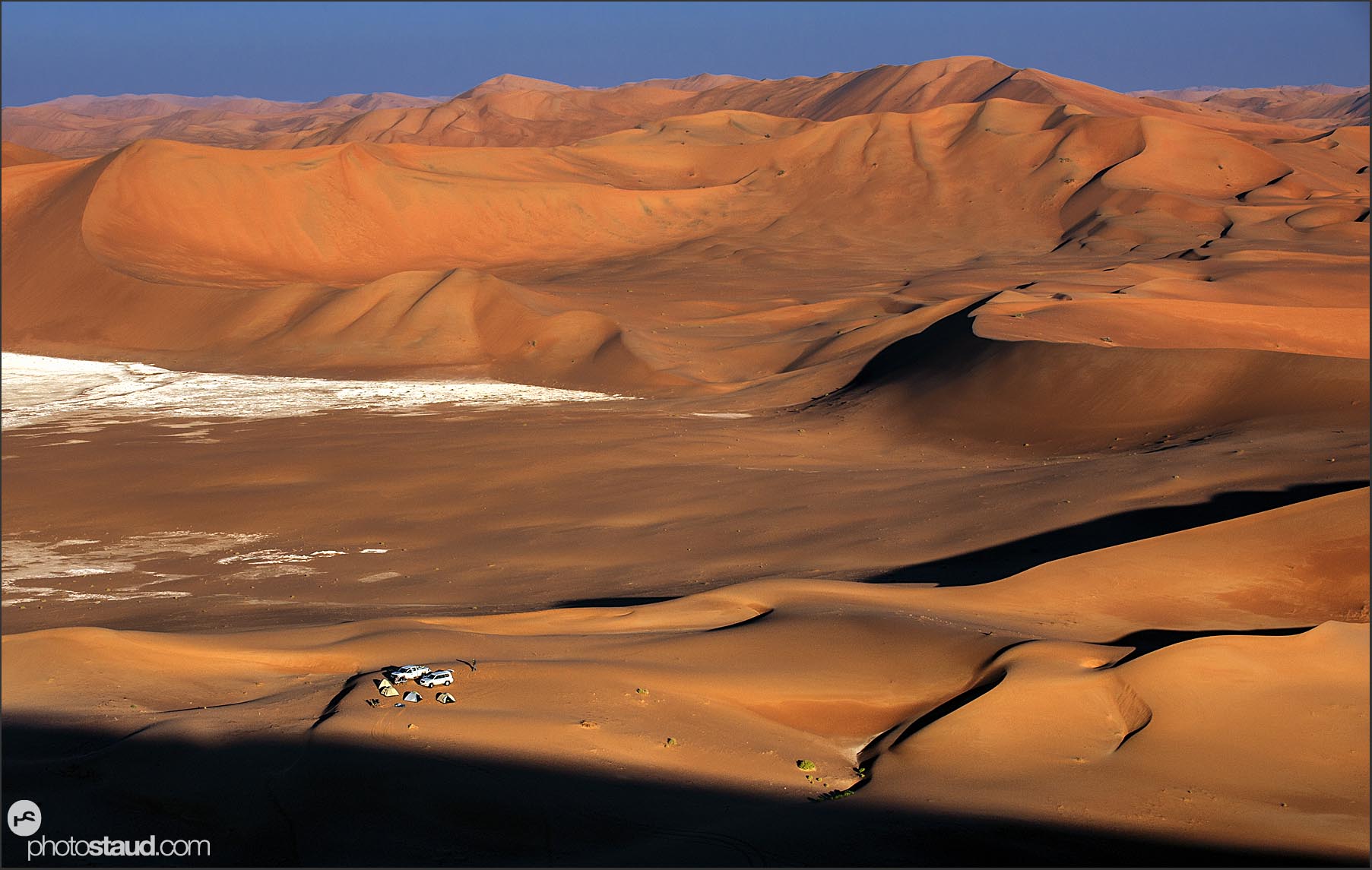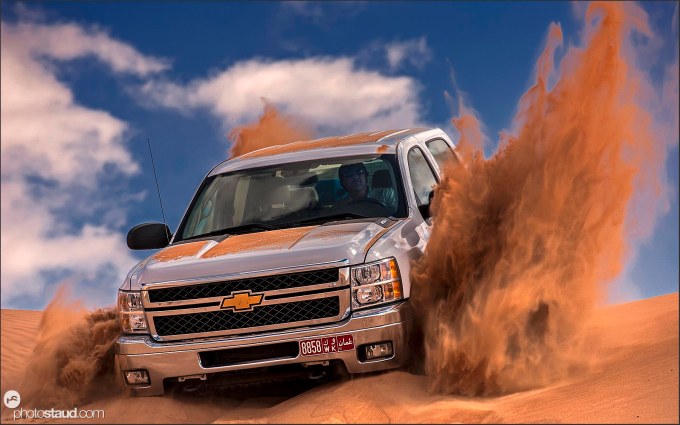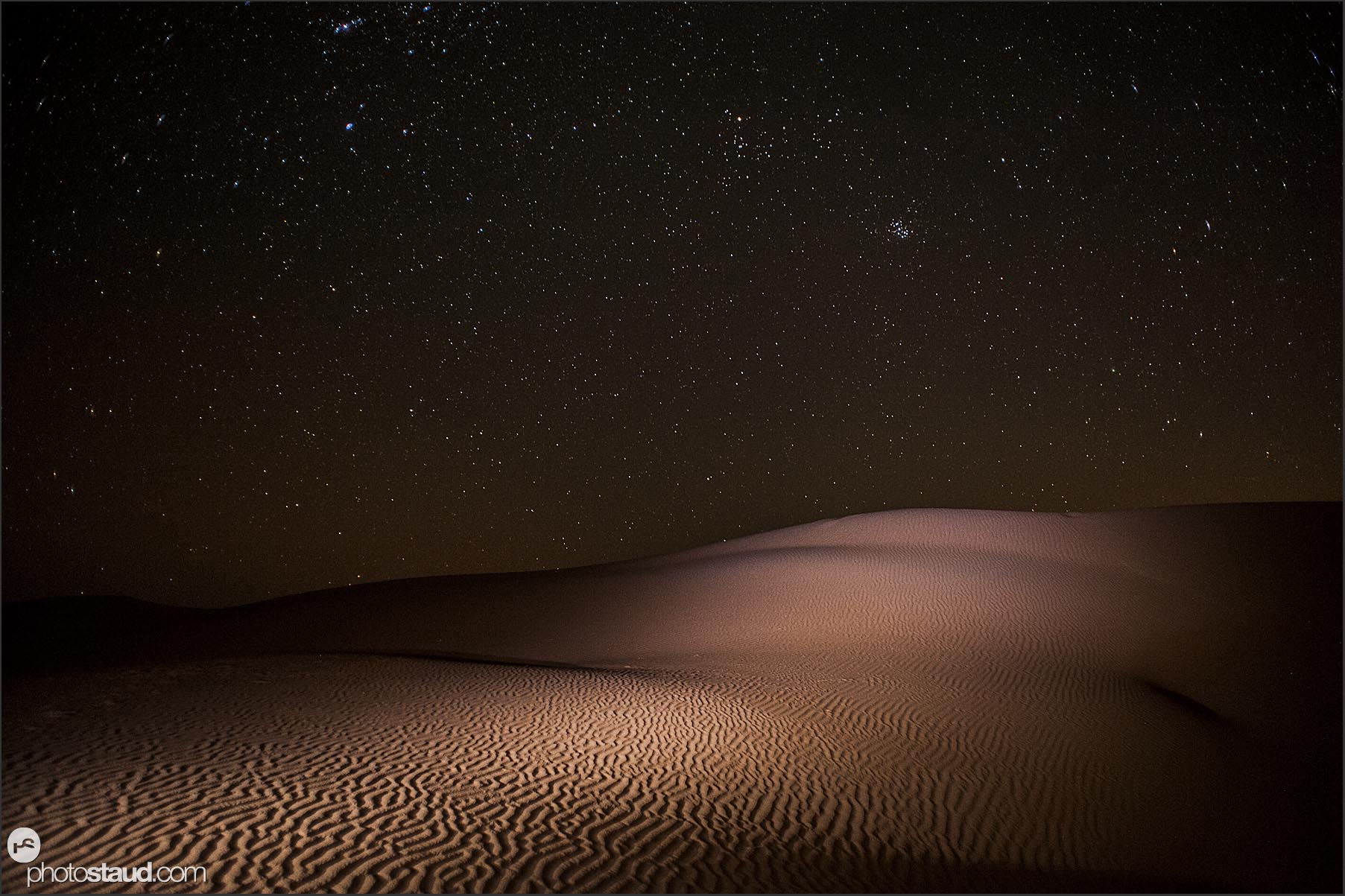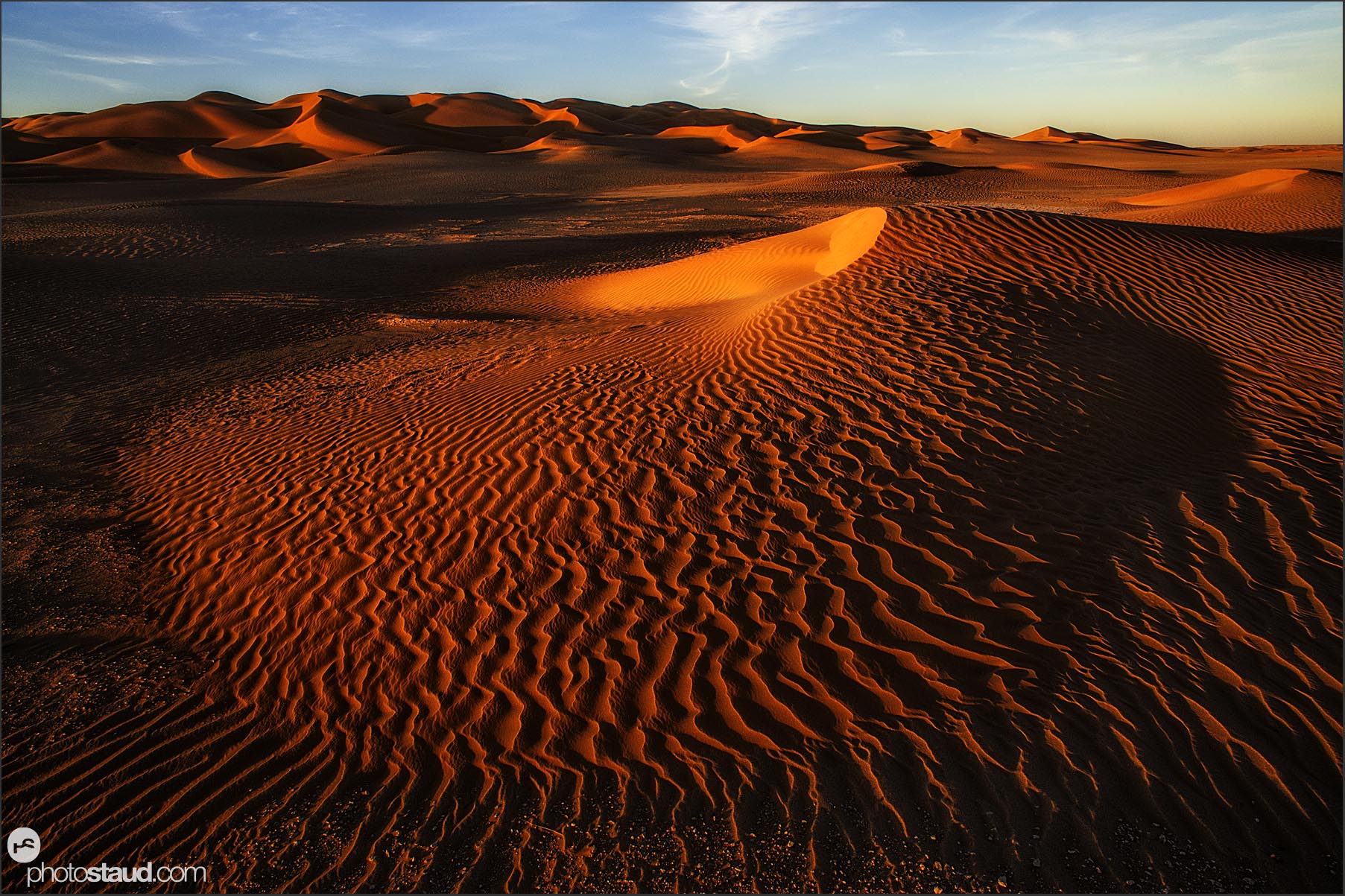Česká verze tady.

I am sitting atop a dune in the Rub Al-Khali desert. Sand as far as the eye can see. Only in the distance I note our little camp crouching in the desert – two cars, two tents and fire – the only sign of civilization for miles. The wind lifts the sand off dune ridges and the setting sun is dying it red-hot – as if flames of fire were leaping around me. After dark, the wind subsides and utter darkness and silence surround me. Through all my senses I am privileged to perceive the meaning of the words “Rub Al Khali” or “Empty Quarter”.
Text and photo (c) by Frantisek Staud/www.photostaud.com
This story was published in a Czech Geographical Magazine – Koktejl. Full royalty pament was sent to Medecins Sans Frontieres

I am in the middle of my voyage through the Sultanate of Oman, a country of Sinbad the Sailor and the Queen of Sheba, a country of breathtaking sceneries, volcanic mountains, chiseled canyons, secluded beaches and ……deserts. My journey begins in the capital, Muscat, and after several hours of comfortable asphalt road we turn the steering wheels towards the north, filling up the tanks of both 4×4 cars and ten reserve canisters to the brim and releasing some air out of the tires. Sand, in all imaginable forms, will be our home for the coming two weeks.
The infamous gateway to Rub al Khali on the border with Saudi Arabia is called “Umm Al Samis” (Mother of poisons). It is a hazardous area of loose sand, salt marsh and no signs of life. The tight-looking crust is very treacherous if it breaks under the wheels of a car. From a distance it looks like a freshly plowed field; if you set your foot on it, it crunches and reveals a snow-white salt under the layer of brown clay. Committed to its name, the Mother of poisons looks very unhospitable and Bedouins have avoided her for ages – so have tourists. Flat horizon all around me is disturbed by occasional projections of fata morgana; and one of them reflects the first contour of Empty Quarter.

With an area of 650,000 square kilometers, the Rub al Khali is the largest sand desert in the world. If you can imagine the whole of France covered with sand, you can imagine the dimensions of the Empty Quarter. “Not even Allah has been there,” Bedouins warned the oilman Thomas Barger, when searching for oil in the late 1940s. Dunes can reach heights of up to 300 meters and their slopes are decorated with symmetrical wrinkles – as if combed by a snowgroomer.

Driving here without experience would be a nightmare, but for our veteran drivers, Tom and Stephan, the steep sand-hills present no obstacle and our offroad whisks us surprisingly easily to any top. Driving across the dunes resembles an elevator ride: someone accidentally presses the buttons and I’m just waiting to see if my stomach is buoyed up or pushed in the opposite direction. It will take me a few days before I get used to this buzzing rollercoaster and will be able to take photographs and write notes. With increasing mileage the desert changes its texture and color – immense red dunes are replaced with wind-formed dunes of barchan type, which are traveling with the wind. My shoes had for long been left abandoned deep in the trunk of my car and I’m enjoying the barefoot luxury. The fine grains of sand, pleasingly chilling in the morning and nicely warm in in the evening, give me the most satisfying caress.

When a “petrol station” appears behind one of the dunes, I can hardly believe my eyes, but a sign on a wooden pole says so, with an empty canister lying in the sand. A twelve-year old Bedouin girl sells her souvenirs to passing tourists. Yet, I see neither petrol, nor tourists. We meet more Bedouins after a few kilometers, adults sitting in the shade of their tents and offering handmade hats, carpets, or sandals. Behind the tents, their children play baseball in the dust, with branches of the palm trees instead of bats. They react to my presence by throwing stones in my direction, which I attribute to their passion for the game and decide to withdraw.
Every evening before sunset, we look up a spot for camping, usually high in the dunes. If you could imagine France covered with sand, then the glittering vault of stars above the desert is simply beyond imagination! Every night I fall asleep by the fire and burning frankincense, gazing into the deep black sky, hesitating if it is Cassiopeia or the Pleiades, who put me to sleep tonight – in the best hotel in the world, the five-(billion)-star hotel “Under the Milky Way”. The night-wind sweeps sand into my sleeping bag, ears, eyes, nose and all other body openings – but I couldn´t care less.

“Rise early, for the hour after sunrise is borrowed from paradise,” an Arab proverb speaks, and here in the Rub Al Khali’s it´s doubly true. Therefore, every night my alarm clock wakes me up at 2 a.m. and, surrounded by sand and stars, I set out into the bowels of the dunes in search for nighttime photographs and the deafening silence. Silence, which we have voluntarily urged from our lives, and which we cannot listen to any more. The mirror and shutter of my camera cuts the night like a gunshot; I feel sorry to disturb the peace and harmony so I carefully consider each exposure. At least I have time to thank the desert for giving me the honor to stay in such a beautiful place, bigheartedly tolerated by scorpions, snakes and spiders.

We continue west along the border with Saudi Arabia, towards Yemen. Along the way we meet abandoned Bedouin shelters, regrettably filthy and full of plastic garbage. Like the rest of the country, the Bedouins have undergone an unprecedented transformation over the last few decades. The famous British explorer, Wilfred Thesiger, who traveled here in the middle of the last century and spent “the most beautiful years of my life” with Bedouins, would hardly recognize them. They drive pickups in the desert, with camels resting on the back of the car as if enjoying a family outing, they shop in the markets, wear jeans, carry plastic bags and communicate with mobile phones. The government has built several settlements for Bedouins all around Oman, each of them featuring hundreds of homes, a mosque, school, hospital and police station. Bedouins do not have to pay rent, only electricity and water. Still they prefer their traditional huts in the desert – barasti – built from palm trees. Barasti have one definite advantage for the nomads; they can be rolled up in no time, like a carpet, thrown on a pickup and driven a few miles away.

Scattered like cauliflowers, forgotten and long fossilized, thousands of geodes are peeping out of the salt plains between the dunes. Hollow spheroids crack under the weight of our cars and let me peek into their bowels; while the outside is uninvitingly gray, eroded by wind, sand and sun, inside I see glittering crystal of limestone, being formed over hundreds of thousands of years.

Several points of the dessert are crisscrossed by dried-up rivers, wadis, in the footsteps of ancient streams. One of the longest, wadi Dawkah, stretches hundreds of kilometers from Saudi Arabia to the Arabian Sea. The entire length is lined with mimosa trees that keep their chance to live only through their roots, searching for water as deep as several tens of meters. Semi-wild camels, as far as they can reach, nibble the green crowns of mimosas, making the trees look like heads with carefully trimmed afro-hairstyles. Completely different is the rocky Wadi Al Haugh, a paradise for geology teachers, witness of the immense volcanic activity and geological chaos. One does not need much imagination to see in every rock formation the face of the last of the Mohicans, or characters from fantasy stories. They all seem ready to run or take off – thousands of years waiting for a command.
Wilfred Thesiger once wisely said that no one leaves the Rub al Khali unchanged. After two weeks of wandering through the sands, the last dunes are disappearing behind the shimmering horizon and the wind has wiped out my footprints. On my cellular I see the first signal of a local operator. Dirty, dusty and boyishly happy I put on my shoes again and step into a luxury seaside hotel near Salalah. Lined with polished marble and scented with oriental fragrance, it opened just a few months ago. Still, I am afraid that its five stars will be infinitely too few for me tonight!

To see more photographs from the deserts of Oman in higher resolution, click on the photo-gallery below:
You bring to life a world here that I’ve long dreamt about ~ a culture and feeling of a land that is so different from the places I’ve lived and traveled. You’ve created wonders here with your photos and words.
Gorgeous imagery! But why would you choose such a title though? “…where Allah wouldn’t go”… i’m sure you didn’t mean anything negative, however, it does come off offensive.
Please do change!
Nothing negative meant, indeed! It just reffers to what Bedouins say about the desert!
No harm… No foul! I suppose I kind of got the expression later… 🙂 Love the images!